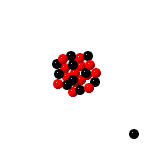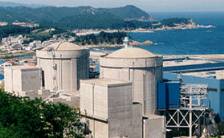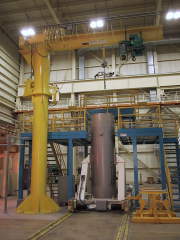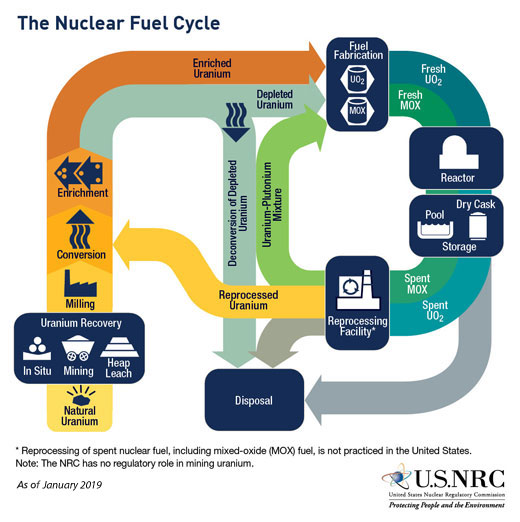HLW
Project
International
HLW programs
| Nagra
is tasked to provide a scientific and technical basis
for the safe disposal of radioactive waste for UK.
The
AECL Underground Research Laboratory (AECL-URL)
is tasked to study the feasibility of safe disposal
of nuclear fuel in the Lac du Bonnet granite batholith
located in Pinawa, Manitoba, Canada.
Posiva
is the expert organization on nuclear waste management
in Finland.
SKB
AB is owned jointly by the four Swedish nuclear
power companies. SKB AB deals with the handling and
storage of the radioactive waste for Sweden.
The
Korea Atomic Energy Research Institute (KAERI) is
responsible for research and development of HLW repository
in Korea.
|
Other
Links
|
When
the natural uranium is mined from underground and open pit
mines, it consists of 99.3 % U-238 and only 0.7% of U-235.
The extracted ore goes through the ordinary mineral dressing
processes (crushing, grinding, screening, flotation, and gravity
separation) to increase the U-235 concentration. It is then
chemically processed to form "yellowcake" (U3O8).
Then, uranium hexafluoride gas (UF6) is produced
by fluorination of U3O8. As a gas, it
undergoes enrichment to increase the U-235 content from 0.7%
to about 3.5%. It is then turned into a hard ceramic oxide
(UO2) for assembly as reactor fuel elements.
The
nuclear fuel consists of cylindrical pellets of compacted
UO2 in 3 to 4 meter long and about 0.1 m in diameter
zircaloy tubes. Approximately, one pellet of UO2
will generate energy equivalent to one ton of coal. About
30 to 60 fuel rods are bundled to form a fuel assembly.
 The
fuel rods in the nuclear reactor generated heat through nuclear
fission. When a neutron is absorbed into a U-235 atom, it
becomes an unstable U-236. By electric repulsion, U-236 splits
into fission products (ex. Barium, Krypton, and etc.). The
binding forces are converted into energy in the form of heat
and Gamma radiation. When this reaction occurs under controlled
environment, two free neutrons will be available for continued
fission processes. The
fuel rods in the nuclear reactor generated heat through nuclear
fission. When a neutron is absorbed into a U-235 atom, it
becomes an unstable U-236. By electric repulsion, U-236 splits
into fission products (ex. Barium, Krypton, and etc.). The
binding forces are converted into energy in the form of heat
and Gamma radiation. When this reaction occurs under controlled
environment, two free neutrons will be available for continued
fission processes.
 A
1-MW nuclear power plant typically contains about 100 tons
of uranium fuel. Once a year, about one-third of the fuel
rods are removed and replaced with fresh fuel. The spent fuel
rods are composed of about 94% of U-238, U-235, radioactive
fission products, and other radioisotopes. Although they represent
a small proportion of the spent fuel, only 3.5%, they are
highly radioactive and continue to generate heat and release
radiation long after the fuel is removed from the reactor.
Most spent
fuel from nuclear power plants is stored in pools of water
at the reactor site, temporarily. The water works as a coolant
and radiation shield. A
1-MW nuclear power plant typically contains about 100 tons
of uranium fuel. Once a year, about one-third of the fuel
rods are removed and replaced with fresh fuel. The spent fuel
rods are composed of about 94% of U-238, U-235, radioactive
fission products, and other radioisotopes. Although they represent
a small proportion of the spent fuel, only 3.5%, they are
highly radioactive and continue to generate heat and release
radiation long after the fuel is removed from the reactor.
Most spent
fuel from nuclear power plants is stored in pools of water
at the reactor site, temporarily. The water works as a coolant
and radiation shield.
 United
States policies governing the permanent disposal of high-level
radioactive waste are defined by the Nuclear Waste Policy
Act of 1982 as amended. This act specifies that high-level
radioactive waste will be disposed of underground, in a deep
geologic repository and that Yucca Mountain, Nevada, will
be the single candidate site for characterization as a potential
geologic repository. This act provides for a procedure and
timetable for the site selection, construction, and operation
of HLW mined geologic repositories. United
States policies governing the permanent disposal of high-level
radioactive waste are defined by the Nuclear Waste Policy
Act of 1982 as amended. This act specifies that high-level
radioactive waste will be disposed of underground, in a deep
geologic repository and that Yucca Mountain, Nevada, will
be the single candidate site for characterization as a potential
geologic repository. This act provides for a procedure and
timetable for the site selection, construction, and operation
of HLW mined geologic repositories.
- Uranium
Fuel Cycle

- Nuclear
Organizations
- The
American Nuclear Society (ANS) is a not-for-profit,
international, scientific and educational organization
established by a group of individuals who recognized
the need to unify the professional activities within
the diverse fields of nuclear science and technology.
- The
International Atomic Energy Agency (IAEA) serves
as the world's central intergovernmental forum for scientific
and technical cooperation in the nuclear field, and
as the international inspectorate for the application
of nuclear safeguards and verification measures covering
civilian nuclear programs.
- The
Nuclear Energy Institute (NEI) is the policy organization
of the nuclear energy and technologies industry and
participates in both the national and global policy-making
process.
- The
World Nuclear Association is the global industrial
organization that seeks to promote the peaceful worldwide
use of nuclear power as a sustainable energy resource
for the coming centuries.
|
|